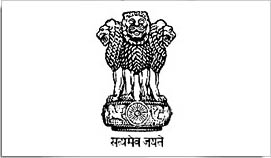State Emblem
Kids: Kids
Stories| General Knowledge | Games|
Quiz |
National Symbols |Links
Stories:
Panchatandra |
Akbar Birbal|
Tenali Raman |
Indian fairy tales |
Aesop stories |
Vikram Betal |
Jataka tales
Arabian Nights |
Aladdin & magic lamp |
Sinbad
|
Mulla
Nazrudeen |
Inspirational -Moral Stories
Missing Children:
Finding Missing Children|
How to Protect your child |
Missing children where they go? |
List of Missing children

The state emblem is an adaptation from the Sarnath Lion Capital of Ashoka. In the original, there are four lions, standing back to back, mounted on an abacus with a frieze carrying sculptures in high relief of an elephant, a galloping horse, a bull and a lion separated by intervening wheels over a bell-shaped lotus. Carved out of a single block of polished sandstone, the Capital is crowned by the Wheel of the Law (Dharma Chakra).
In the state emblem, adopted by the Government of India on 26 January 1950, only three lions are visible, the fourth being hidden from view. The wheel appears in relief in the centre of the abacus with a bull on right and a horse on left and the outlines of other wheels on extreme right and left. The bell-shaped lotus has been omitted. The words Satyameva Jayate from Mundaka Upanishad, meaning 'Truth Alone Triumphs', are inscribed below the abacus in Devanagari script.
Source: India 2010 - A Reference Annual / http://india.gov.in/knowindia/state_emblem.php


